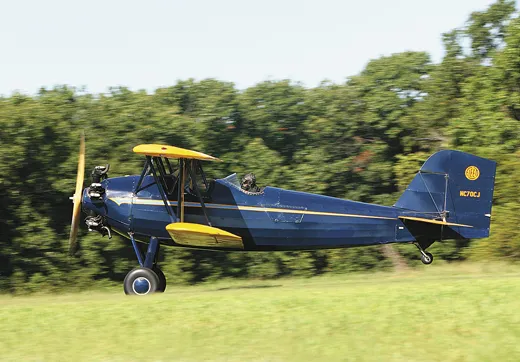Restoration: Fleet Model 8
Three brothers, an inspiring teacher, and the airplane in the barn.
/https://tf-cmsv2-smithsonianmag-media.s3.amazonaws.com/filer/restoration_631-feb08.jpg)
McConnell Air Force Base in Kansas is named after the McConnell brothers, Fred, Thomas, and Edwin, who gained a measure of fame during World War II. “The flying McConnell brothers,” brought up in the pre-war aviation milieu in Wichita, joined the Army Air Corps together, trained together, and served together. Their mother, Anna, pinned on their wings at the completion of their pilot training at Luke Field in Phoenix, an event widely reported in newspapers.
On July 10, 1943, the brothers flew three B-24 Liberators on a 13th Air Force mission from Henderson Field on Guadalcanal, in the Solomon Islands, to Bougainville. On the return trip, Tom and his aircraft and crew were lost in bad weather. Fred went on to fly a total of 61 combat missions in the Pacific theater; Edwin flew 56 missions and was then transferred Stateside.
Fred remained in the Army Air Forces after the war, and in October 1945 he was transferred to the Army Air Field in Garden City, Kansas. On October 21, Fred and his wife, Mary Louise, known as Blondie, departed Wichita en route to Garden City in Fred’s 1931 blue-and-yellow open-cockpit Fleet Model 8 biplane. In the front cockpit with Blondie were linens for their new house in Garden City. Twenty-five miles west of Wichita, the Fleet hit a power line and crashed. Blondie survived; Fred, however, who, according to the Civil Aeronautics Administration accident report, was not wearing his seat belt, was killed.
In 1954 Blondie and her children, Tommy, Nancy, and Kittie Lou, attended the dedication of McConnell Air Force Base. Kittie Lou was very young when her father was killed, but remembers him and this detail of the dedication: “General H.R. Spicer sent a B-17 to pick us up.” Edwin McConnell died in 1997 at the age of 76, and in 1999 the base was re-dedicated to include his name. And that would have been the end of the story had it not been for Jim Bumgarner’s aviation maintenance class.
Jim Bumgarner is all about airplanes. After flying more than 70 missions as a C-47 engineer during the Korean War, Bumgarner returned to Missouri, where he worked for the Army Air Guard and ran a fixed-base operation at Skyhaven Airport in Warrensburg. When the University of Central Missouri started an aviation program in 1968, he became chief of maintenance and oversaw development of the operation into a program comprising more than 40 aircraft. Students under his supervision maintained the fleet, and when one student casually mentioned that an airplane had been abandoned on his family farm in Kansas, Bumgarner’s curiosity was piqued.
He drove over and found a fuselage center section. After some detective work, he found parts of the airplane’s empennage hanging in a neighbor’s shed, some landing gear parts and a baggage compartment door at a nearby high school, and the fuselage aft of the cockpit serving as an ornamental windmill in the garden of a farmer. (Bumgarner welded a replacement to trade him for the fuselage.) An area adjacent to the farm’s accident site had over the years become a junk pile, filled with barbed wire, corrugated
tin siding, and trash. In Bumgarner’s words, “Anything that was airplane, we pulled out of it.” A tree at the site had to be felled to free a wingtip it had grown around. The accumulated material was just enough to fill the back of his pickup.
Bumgarner determined the make of the aircraft from the singular construction of the wing ribs. A serial number on the baggage compartment door enabled him to obtain extensive documentation from the Federal Aviation Administration. The airplane was a Fleet Model 8, and its last registered owner was Fred McConnell. A block of 15 serial numbers had been allotted for the model; seven were produced. The only other extant Fleet Model 8 that Bumgarner knows of is in the New York State Museum in Albany.
The restoration started as a blue chalk line snapped on the concrete floor of the hangar. Most of the parts had to be painstakingly reproduced. Bumgarner fashioned the top wing spar, a single piece of laminated wood, 28 feet from tip to tip. One of the few pieces of original equipment is the airplane’s Heywood Air Starter. Bumgarner was lucky enough to locate dies to stamp the unique hat section wing ribs. “If I had to do it over again,” he says, “I’d start with soft aluminum and send them to be hardened later.” To determine the dimensions needed to fabricate the struts, a New York student heading home for vacation was dispatched to the museum in Albany with a camera and tape measure.
During the restoration, Bumgarner discovered that the rear seat belt attachment fittings had been torn out of the fuselage; the accident report was incorrect. “I found it hard to believe that an experienced pilot like Fred would be flying without a seat belt,” Bumgarner says. He also has an opinion about the accident: “It was windy that day and he was probably flying low into the setting sun to stay out of the worst of the wind. The Kinner engine has a habit of specking up the windshield with oil from the rocker boxes. Those conditions could make it difficult to see and avoid a wire.”
The Fleet came to life in 1995, 11 years after the restoration began, and more than 45 years after it was left for dead on the Kansas prairie. This airplane is not a hangar queen; it’s flown regularly to aviation fly-ins. Bumgarner and Kittie Lou are in touch, and Kittie Lou plans to come out in 2008 to meet Bumgarner and the Fleet. She’s looking forward to seeing the prairie sky from the best seat in the house—as Blondie did so many years ago.
